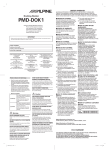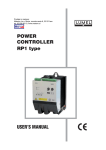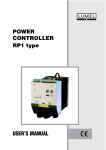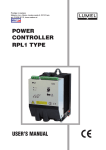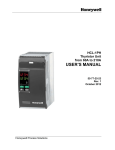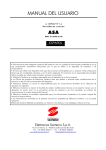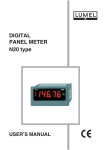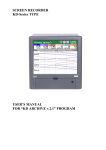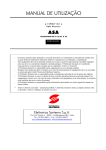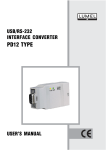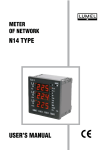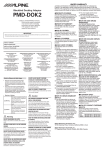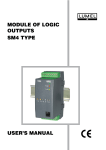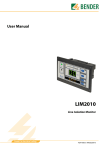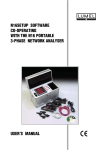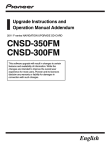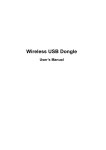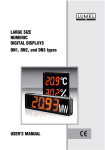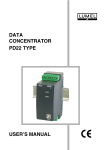Download USER`S MANUAL THREE-PHASE POWER CONTROLLER RP3 Type
Transcript
THREE-PHASE POWER CONTROLLER RP3 Type USER’S MANUAL 2 THREE-PHASE POWER CONTROLLER RP3 Type USER’S MANUAL CONTENTS 1. APPLICATION...............................................................................................5 2. BASIC REQUIREMEMNTS, OPERATIONAL SAFETY ...............................5 3. POWER CONTROLLER SET .......................................................................6 4. INSTALLATION .............................................................................................6 4.1. Overall and assembly dimensions.........................................................6 4.2. Electrical connections............................................................................8 4.3. Selection of the control type ..................................................................8 4.4. Connection of control signals ................................................................9 4.5. Connection of supply and load ............................................................12 5. POWER CONTROL SERVICE ...................................................................15 6. DESCRIPTION OF CONTROL TYPES ......................................................16 6.1. Control of ON-OFF type ......................................................................16 6.2. Impulse control ....................................................................................17 6.3. Phase control ......................................................................................19 6.4. Limitation of the load current ...............................................................19 6.5. Triggering delay of soft-start type ........................................................19 6.6. Control of the input line amplification ..................................................20 6.7. Control and current signalling in the load circuit..................................20 6.8. Signalling of supply correctness ..........................................................20 6.9. Signalling of maximal radiator temperature exceeding .......................21 6.10. Error signalling ..................................................................................21 6.11. Overload protection ...........................................................................21 7. SPECIFICATIONS.......................................................................................22 8. ORDERING CODES ...................................................................................24 9. MAINTENANCE AND WARRANTY ...........................................................24 3 4 1. APPLICATION The RP3 power controller is a contactless three-phase power energy electronic device which includes a thyristor connector and an electronic gate triggering system. This power controller allows the control of the power delivered from a threephase voltage source to an electrical energy load in function of the control signal input. The RP3 power controller is destined for three-phase actuators with resistance or resistance-inductance loads in control systems and automatic temperature control. The application area of RP3 power controllers comprises: electrical furnaces and drying constructions, particularly industrial tunnels and belt- type furnaces, furnaces for annealing and hard soldering, crucible furnaces and smelters, furnaces for hardening in salt baths. devices of mechanical engineering, aggregates and extruding presses for plastics, devices, for winding and tempering of springs, spot welding and seam welders, production of glass and glazing, installations and devices for drying in infrared and ultraviolet radiation, ladles for glass melt and heating of feeding devices, furnaces for glass forming. chemical and petroleum industries, facing heaters of tube installations, preheating installations. 2. BASIC REQUIREMENTS, OPERATIONAL SAFETY Power controllers are applied in high-current installations in which live devices occur, that can be a source of hazard. Considering the personnel safety, one should observe following principles: Devices can be installed, serviced and maintained exclusively by a suitably qualified personnel, having essential knowledge about equipment. RP3 power controllers should be connected to the power network according to the present operative regulations and standards concerning electrical installations, and concerning specially the protection against electric shocks During the start and operation of the starting system, one must comply with recommendations included in this user’s manual (and specially to sections 4, 5 and 6). Qualified personnel defines persons which are acquainted with the user’s manual, assembly starting and service of the product, and have appropriate qualifications to carry out these activities. 5 Symbols located in this user’s manual mean: WARNING! Warning of potential, hazardous situations. Especially important. One must be familiar with this before connecting the power controller. The non-observance of notices marked by these symbols can occasion severe injuries of the personnel and the damage of the device. CAUTION! Designates a general useful note. If you observe it, handling of the power controller is made easier. One must take note of this, when the power controller is working inconsistently to the expectations. Possible consequences if disregarded ! In the security scope the power controller meets the requirements of the LowVoltage Directive (EN 61010 -1). Remarks concerning the operator safety: 1. General - The RP3 power controller is destined to co-operate with other devices. - Non-authorized removal of the required housing, inappropriate use, incorrect installation or operation creates the risk of injury to personnel or damage to equipment. For more detailed information please study the user’s manual. - All operations concerning transport, installation, and commissioning as well as maintenance must be carried out by qualified, skilled personnel and national regulations for the prevention of accidents must be observed. - According to this basic safety information, qualified, skilled personnel are persons who are familiar with the installation, assembly, commissioning, and operation of the product and who have qualifications necessary for their occupation. 2. Transport, storage Please observe the notes on transport, storage and appropriate handling. Observe the climatic conditions given in Technical Data. 3. Installation - The power controller must be installed according to the regulation and instructions given in this user’s manual. - Ensure proper handling and avoid mechanical stress. 6 - Do not bend any components and do not change any insulation distances. - Do not touch any electronic components and contacts. - Electronic Instruments may contain electrostatically sensitive components, which can easily be damaged by inappropriate handling. - Do not damage or destroy any electrical components since this might endanger your health! 4. Electrical connection - Before switching the power controller on, one must check the correctness of connection to the network. - In case of the protection terminal connection with a separate lead one must remember to connect it before the connection of the power controller to the mains. - When working on live instruments or devices, the applicable national regulations for the prevention of accidents must be observed. - The electrical installation must be carried out according to the appropriate regulations (cable cross-sections, fuses, PE connection). Additional information can be obtained from the user’s guide. - The documentation contains information about installation in compliance with EMC (shielding, grounding, filters and cables). These notes must be observed for all CE-marked products. - The manufacturer of the installation or installed devices is responsible for the compliance with the required limit values demanded by the EMC legislation. 5. Operation - Installations including RP3 power controllers must be equipped with protection devices according to the corresponding standard and regulations for prevention of accidents. - After the power controller has been disconnected from the supply voltage, live components and power connections must not be touched immediately because capacitors can be charged. - The housing must be closed during operation. 6. Maintenance and servicing - Please observe the manufacturer’s documentation. Read all product-specific safety and application notes in this user’s manual. Before taking the power controller housing out, one must turn the supply off. The removal of the power controller housing during the warranty contract 7 3. POWER CONTROLLER SET The set consists of: – RP3 power controller – user’s manual – warranty card – quick start card 1 pc. 1 pc. 1 pc. 1 pc. When unpacking the power controller, please check the delivery completeness and whether the type and version code on the data plate correspond to the order. 4. INSTALLATION 4.1. Overall and assembly dimensions The RP3 power controller is destined to be mounted on a wall by means of holders. Power controller overall dimensions, spacing of assembly holes and the fixing way are presented on fig.1 and 2. In case of mounting in control cubicles, it is recommended to apply a forced air cycle. Fig. 1. Overall dimensions and fixing way of the power controller for 40 A, 70 A and 125 A versions. 8 Fig. 2. Overall dimensions and fixing way of the power controller for 200 A, 300 A, and 450 A versions. Fig. 3. Panel. 9 Following Servicing elements are disposed on the power controller frontal plate (Fig.3). Signalling diodes: Control - two-colour diode [1], supply correctness and power controller readiness to work. Load - two-colour diode [2], passage of current through the load (when I load > 5%I N of the controller). Stop - red diode [3], external triggering stoppage. Error - red diode [4], control error or incorrect supply connection. Over Temp. - red diode [5], exceeding of the allowable temperature. Fuse Fail - red diode [6], fuse burnout. Potentiometers and switch: S-START - potentiometer [7], control of the soft-start function duration. Limit - potentiometer [8], limitation of the load current. Span - potentiometer [9], control of the input line amplification. Switch - DIP-SWITCH [10], to configure analog inputs and the control mode. 4.2. Electrical connections One must carry out electrical connections by means of following wires: a) to LZ1 terminal strips (fig.3) - wires with cross-section from 0.35 up to 2.5 mm2, b) to high-current terminals (fig.1 and 2): RP3-1x version; 40 A - wires of 16 mm2 cross-section, RP3-2x version; 70 A - wires of 25 mm2 cross-section, RP3-3x version; 125 A - wires of 50 mm2 cross-section, RP3-4x version; 200 A - rail of 100 mm2 cross-section, RP3-5x version; 300 A - rail of 200 mm2 cross-section, RP3-6x version; 450 A - rail of 300 mm2 cross-section. c) to the protective terminal - wire (rail) of a cross-section at least the same as wires in the high-current circuit. 4.3. Selection of the control type Depending on the kind of control and the input control signal, one must suitably set sections of the DIP, according to the table 1. One must choose the kind of control at turned UWB supply off, (see p. 4.5.). 10 Table 1. DIP switch section Input control signal Kind of control Load configuration 0...5 V 0...10 V 0...20 mA 4...20 mA Phase Pulse - quick cycle Pulse - slow cycle On-Off (switching instantly) 1 2 1 0 0 0 0 0 0 1 Three-, six-wire* / four-wire 3 4 0 0 1 0 1 0 1 1 5 0/1 0 - open switch, 1 - shorted switch, - state resulting from other settings. *) - the load six-wire configuration requires the correction of the ,,Span” potentiometer (one must set the potentiometer slide on the half range). 4.4. Connection of control signals 4.4.1. Connection of control to the LZ1 terminal strip It is recommended to use shielded wires and a separate guidance of the control installation and the high-current installation to connect control signals to the LZ1 erminal strip. Fig. 4. Description of the LZ1 terminal strip. 11 4.4.2. Input control signal Fig.5. Connection of control signals. a) by analog signal The control from a voltage or current control signal source or from the potentiometer is possible. In case of control from the potentiometer, the voltage input should be set on the 0...5 V range. b) by impulse signal One must connect the control signal (4...32 V) to terminals of the voltage input In-U, set on the 0...5 V range. 4.4.3. Tripping stoppage Fig.6. Tripping stoppage. There is the possibility to carry out the tripping stoppage by shorting terminals 5 V and Stop on the terminal strip. The Stop input is active in the range of voltages 4...32 V/5 mA. 12 4.4.4. Analog outputs a) Output U = f (Io) 0...5 V/5 mA output voltage, proportional to the current value in the load circuit. Note: The measurement has a reference character. Fig.7. Analog outputs. 4.4.5. Relay outputs Semiconductor relays of MOSFET type. a) Output PK1. - signalling at least one of the damaged fuse - Fuse Fail - error of control or improper connection of the supply (lack of supply or wrong phase sequence) - Error b) Output PK2. - active signal of triggering stoppage - STOP, - exceeding of the allowable radiator temperature - OverTemp. IN = 60 mA/ 230 V a.c./d.c. Ron = 35 W Uisol = 1500 VRMS Voltageless outputs, they are not protected against overloads or shortings. Fig. 8. Relay outputs. 13 4.5. Connection of supply and load The power controller supply (Gate triggering system - UWB) must be connected to L1 and N terminals of the LZ1 strip (fig.3.). The supply of the strong-current circuit must be connected to U1, V1, W1 terminals, however the load circuit to U2, V2, W2 terminals (fig.1. and fig.2.) Fuses in version RP3 -1x , 2x and 3x are accessible after removing the protection cover, fig.1. 4.5.1. Load connection in a 3- and 4-wire system. a) 3-wire load. b) 4-wire load V. 14 4.5.2. Load connection in a 6-wire system. a) 6-wire load. Fig. 9.Relay outputs. 5. POWER CONTROLLER SERVICE „S-Start” and „Limit” potentiometers must be set on minimum, and the „Span” potentiometers, on maximum. In such settings, corresponding functions to them are inactive. One must carry out successively following operations: a) install the power controller, according to p.4.1. b) carry out electrical connections, according to p. 4.2., p. 4.4. and p. 4.5. c) set the control type and the input control signal, according to p. 4.3. d) turn on the supply voltage of the load circuit and next, the gate triggering system UWB, according p. 4.5. e) set the current limitation*, according to p. 6.4. Set the „Limit” potentiometer on maximum. Observing indication of the meter measuring the load current (at the maximal value of the input control signal), set the required current value decreasing the setting on the „Limit” potentiometer. f) set the triggering delay*, according to p.6.5. g) set the amplification of the input line*, according to p. 6.6. *) One can reach experimentally the obtainment of proper settings by means of potentiometers and this should be carried out by a suitably trained personnel. 15 6. DESCRIPTION OF CONTROL TYPES 6.1. Control of ON-OFF type At the on-off control, the delivered power to the load is described by the following dependence: [1] Where: Po - delivered power to the load, Xin - value of the input control signal. The power controller works in the semi-conductor relay mode. The feed of the voltage signal on the control input, p. 4.4.2b, causes the instantly turn of the load current on. The turning on with using the Soft-Start function is possible. Runs of signals describing the power controller operation for the control of on-off type are shown on the fig.10. Voltage supplying the load circuit Impulse input signal Current in the load circuit Fig.10. Control of on-off type, runs of occurring signals in relation to the neutral wire - resistance load. 16 6.2. Impulse control Pulse control consists on the change of the pulse-duty factor and the frequency of power Po delivered to the load in function of the analog control signal, at the same time the output current is turned on synchronously with the transition of the supply voltage across zero. Runs of signals are presented on the fig.11. The power value in the pulse period according to the formula [2], is defined by the dependence [3]: [2] T = Ts (Non + Noff) Po = Po max Where: Ts Non Noff Non Non + Noff = Po max X in X in max [3] - period of the supply voltage, - number of turned periods on, - number of turned periods off. Continuous input signal Supplying voltage of load circuit Delivered power to the load Fig. 11. Impulse control with a variable impulse frequency, runs of occurring signals . The RP3 power controller has following kinds of pulse control: Quick cycle, in which for X = 1/2 (Xmax - Xmin), Non = Noff 25, however fi,max 1 Hz, Slow cycle, in which for X = 1/2 (Xmax - Xmin), Non = Noff 250, however fi,max 0.1 Hz. Where: X - value of the analog control signal, fi, max - maximal impulse frequency. 17 Runs of characteristic quantities for the impulse control are presented on the fig.12. The filling factor y is described by the following dependence: J [4] Non Non + Noff Fig.12. Runs of characteristic quantities for the impulse control with variable pulse frequency. 6.3. Phase control At phase control, a continuous change of delivered power to the load occurs, it is realised by the change of the load current turning on angle in the function of the analog control signal. Runs of signals for this kind of control for a resistance load are presented on the fig.13. Continuous input signal Supplying voltage of load circuit Current in the load circuit Fig.13. Phase control, runs of occurring signals, runs of occurred signals in relation to the neutral wire - resistance load. 18 6.4. Limitation of the load current If the current value in the load circuit exceeds the boundary value set by means of the „Limit” potentiometer, then the current limitation operates regardless of the control signal value. It is possible to assign it from an external potentiometer, p. 4.4.3. The setting of the potentiometer on minimum, means the turn of the current limitation operation off. The maximal value of the current flowing in the load circuit can be set in the full range of the power controller rated value. The current limitation does not operate for the on-off control type in the turn-on configuration at across zero voltage. In case of exceeding of the current boundary value, the ,,Load” diode is alight in red. 6.5. Triggering delay of soft-start type The soft-start function enables a soft accretion of the voltage from zero up to the rated value or value resulting from the current limitation action, in the time set by means of the „S-Start” potentiometer. In the case of phase control or on-off control type, the soft-start time ts-s is controlled in the range from 0 up to 10 s. In case of the impulse control, this time is equal to: t S-S = 1 4 fi, max [5] 6.6. Control of the input line amplification The ,,Span” potentiometer serves to set the input line amplification, in the control range from 50 to 100% of the input control signal. NOTE: in case of the load control in the six-wire configuration, one must set the slide of the ,,Span” potentiometer on the half range. 6.7. Inspection and signalling of the current in the load circuit The passage of current in the load circuit is signalled by means of a two-colour „Load” diode. During the normal work, the diode is alight in green, however in the moment of the current limitation action it is alight in red. 6.8. Signalling of the supply correctness The two-colour „Control” diode is alight in green when the power controller is ready to work. 19 6.9. Signalling of maximal radiator temperature exceeding The exceed of the 85 C radiator temperature causes the automatic triggering stoppage and the display of signalling on the „Over Temp” diode, and the PK2 relay turning on, p.4.4.6b. The restart of the power controller is possible after the radiator cooling below 60 C and the supply turning on to UWB again, p.4.5.1. 6.10. Error signalling The power controller submits the error in following cases:: a) improper phase sequence, b) lack of supply on U1, V1, and W1 terminals - simultaneously, c) the current flows through the load despite of lack of triggering impulses, e.g. as the result of a thyristor module damage,. In case of an error statement, the automatic triggering stoppage and the display of the „Error” diode follows, and the PK1 relay turning on, p. 4.4.5a. The restart of the power controller is possible after removing damage reasons and the renewed supply turning on to UWB, p. 4.5. 6.11. Overload protection The output circuit of the power controller is protected against its overload. The protection is set on 125% of the power controller rated current. The exceeding of this value will cause the action of current limitation. 20 7. SPECIFICATIONS Electrical parameters of the strong-current circuit. Table 2 Fuse parameters Max. output current Supply voltage of the load circuit Max. load power Lost power in thyristors Çi2 dt at 415 V 40 A 3~400 V/50 Hz 30 kW < 200 W 440 [A2s] 50 A 70 A 3~400 V/50 Hz 53 kW < 350 W 3600 [A2s] 100 A 100FE - Bussmann 6.9 URB 000 BS 88/100 - FERRAZ 125 A 3~400 V/50 Hz 95 kW < 600 W 9600 [A2s] 160 (200) A 200FEE - Bussmann 6.9 URB 000 BS 88/160 - FERRAZ 200 A 3~400 V/50 Hz 152 kW < 950 W 28500 [A2s] 250 A 250FM - Bussmann 6.9 URC 000 BS 88Z/250 - FERRAZ 300 A 3~400 V/50 Hz 229 kW < 1500 W 68500 [A2s] 350 A 350FM - Bussmann 6.9 URC 000 BS 88Z/355 - FERRAZ 450 A 3~400 V/50 Hz 343 kW < 2200 W 180000 [A2s] 500 A 500FMM - Bussmann 6.9 URC2.000 BS 88Z/500 - FERRAZ Minimal input current Leakage current Kind of load Designation / manufacturer 50FE - Bussmann 6.9 gRB 000 BS 88/50 - FERRAZ 1% of In range of the power controller output current 20 mA resistance or resistance-inductance load acc. to EN 60947-4-2 and EN 60947-4-3 Electrical parameters of the supply and control circuit: - UWB supply voltage 195...230...253 V a.c. - supply voltage frequency 50 Hz - power consumption x 8 VA - voltage control input 0...5 V R in = 20 k: 0...10 V Rin = 40 k: - current control input 0(4)...20 mA Rin = 125 : - impulse control input 0/4...32 V Rin = 20 k: - STOP signal input 4...32 V/5 mA - load-carrying capacity of 5 V output 25 mA 21 - load-carrying capacity of Io output - load-carrying capacity of relay outputs Other parameters: - working temperature - storage temperature - humidity - working position - dimensions: - versions 40 A, 70 A, 125 A - versions 200 A, 300 A, 450 A - weight: - versions 40 A, 70 A, 125 A - versions 200 A, 300 A, 450 A Safety requirements: - maximal phase-to-earth working - pollution degree - installation category - protection degree from terminal side - housing protection degree 5 mA/5 V 60 mA/350 V, R on = 35 :, Uizol =1500 VRMS 0... 40 C -25... 55 C < 90%, without condensation vertical 212 318 177 mm 383 433 281 mm 8.5 kg 37 kg 320 V for power and supply voltage circuits, 50 V for other circuits 2 III IP 00 acc. to EN 60529 IP 20 acc. to EN 60529 Electromagnetic compatibility: - immunity noise EN 60947-4-2, EN 60947-4-3 - emission noise EN 60947-4-2, EN 60947-4-3 The RP3 power controller fulfils requirements of the EN 60947-4-3 standard. The power controller overload capacity is defined by parameters of the applied WARNING: This product is an equipment of class A. Its application in an habitat environment can cause radio interference, what can require the use of additional preventive measures by users to limit disturbances. In case of phase control, the power controller fulfils requirements of the electromagnetic compatibility in relation to the interference emission, only when working near of the supply voltage transition through zero. 22 8. ORDERING CODES Table 3 Power controller RP3 Current range: maximal output current maximal output current maximal output current maximal output current maximal output current maximal output current X X 40 A 70 A 125 A 200 A 300 A 450 A load voltage: 3 ~ 400 V a.c. 50 Hz 1 2 3 4 5 6 Acceptance tests: without an additional quality inspection certificate .................................8 with an extra quality inspection certificate .............................................7 other requirements ................................................................................X ORDERING EXAMPLE The code: RP3 - 3 - 8 means: RP3 - power controller of RP1 type, 3 - maximal output current: 125 A, for the range of voltage: 3 - 400 V supplying the load circuit, 8 - without an additional quality inspection certificate. 23 9. MAINTENANCE AND WARRANTY The RP3 power controller does not require any special periodical maintenance. In case of some incorrect operations: After the dispatch date and within the period stated in the warranty card One should return the power controller to the Manufacturer’s Quality Inspection Dept. If the device has been used in compliance with the instructions, the Manufacturer guarantees to repair it free of charge. The disassembling of the housing causes the cancellation of the granted Warranty. After the warranty period One should send the device to repair it in an authorized service workshop. Spare parts are available for the period of five years from the date of purchase. Our policy is one of continuous improvement and we reserve the right to make changes in design and specifications of any products as engineering advances or necessity requires and revise the above specifications without notice. 24 25 26 27 RP3-07 (17.05.2010) Lubuskie Zak³ady Aparatów Elektrycznych - LUMEL S.A. ul. Sulechowska 1, 65-022 Zielona Góra, Poland Tel.: (48-68) 32 95 100 (exchange) Fax: (48-68) 32 95 101 www.lumel.com.pl e-mail:[email protected] Export Department: Tel.: (48-68) 329 53 02 or 53 04 Fax: (48-68) 325 40 91 e-mail: [email protected] 28




























